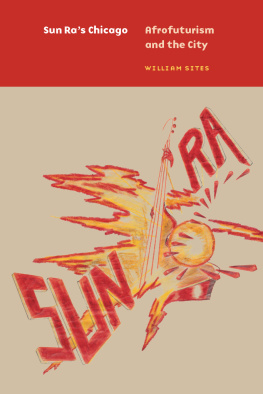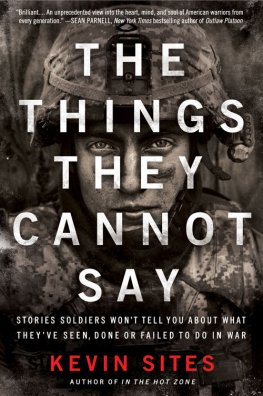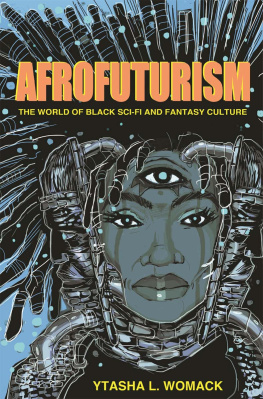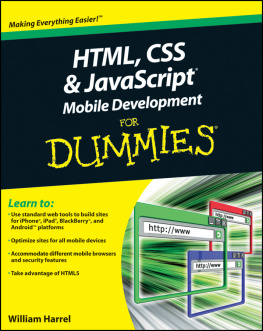William Sites - Afrofuturism and the City
Here you can read online William Sites - Afrofuturism and the City full text of the book (entire story) in english for free. Download pdf and epub, get meaning, cover and reviews about this ebook. year: 2020, publisher: University of Chicago Press, genre: Art. Description of the work, (preface) as well as reviews are available. Best literature library LitArk.com created for fans of good reading and offers a wide selection of genres:
Romance novel
Science fiction
Adventure
Detective
Science
History
Home and family
Prose
Art
Politics
Computer
Non-fiction
Religion
Business
Children
Humor
Choose a favorite category and find really read worthwhile books. Enjoy immersion in the world of imagination, feel the emotions of the characters or learn something new for yourself, make an fascinating discovery.
- Book:Afrofuturism and the City
- Author:
- Publisher:University of Chicago Press
- Genre:
- Year:2020
- Rating:5 / 5
- Favourites:Add to favourites
- Your mark:
- 100
- 1
- 2
- 3
- 4
- 5
Afrofuturism and the City: summary, description and annotation
We offer to read an annotation, description, summary or preface (depends on what the author of the book "Afrofuturism and the City" wrote himself). If you haven't found the necessary information about the book — write in the comments, we will try to find it.
Afrofuturism and the City — read online for free the complete book (whole text) full work
Below is the text of the book, divided by pages. System saving the place of the last page read, allows you to conveniently read the book "Afrofuturism and the City" online for free, without having to search again every time where you left off. Put a bookmark, and you can go to the page where you finished reading at any time.
Font size:
Interval:
Bookmark:
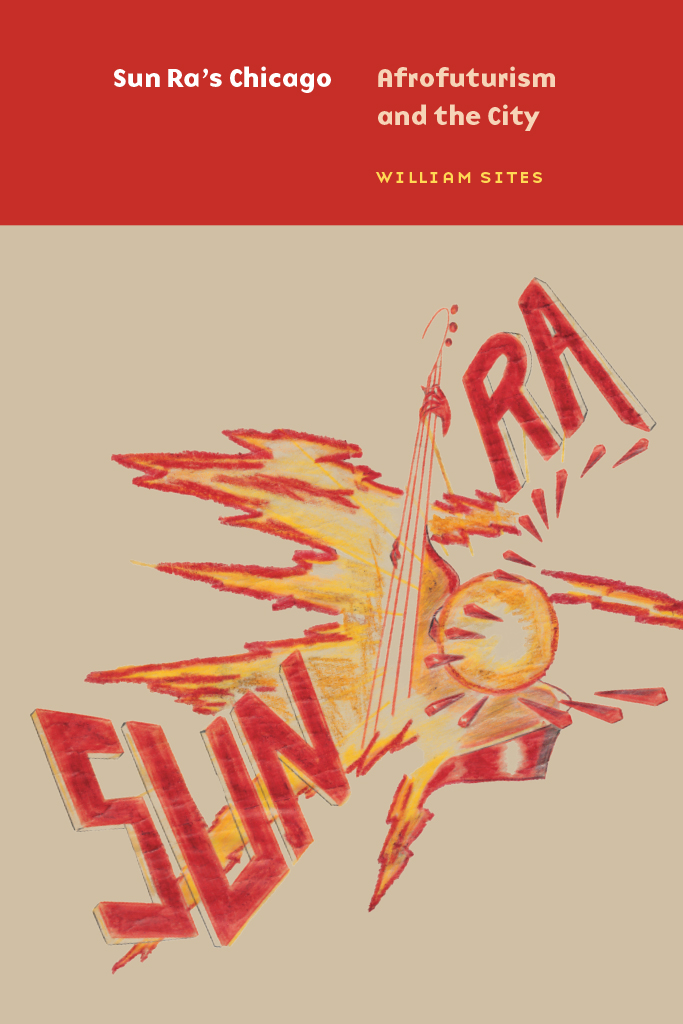

Edited by Lilia Fernndez, Timothy J. Gilfoyle, Becky M. Nicolaides, and Amanda I. Seligman
James R. Grossman, Editor Emeritus
RECENT TITLES IN THE SERIES
Steven T. Moga, Urban Lowlands: Environment and Poverty in Urban History
Andrew S. Baer, Beyond the Usual Beating: The Jon Burge Police Torture Scandal and Social Movements for Police Accountability in Chicago
Ann Durkin Keating, The World of Juliette Kinzie: Chicago before the Fire
Jeffrey S. Adler, Murder in New Orleans: The Creation of Jim Crow Policing
David A. Gamson, The Importance of Being Urban: Designing the Progressive School District, 18901940
Kara Schlichting, New York Recentered: Building the Metropolis from the Shore
Mark Wild, Renewal: Liberal Protestants and the American City after World War II
Meredith Oda, The Gateway to the Pacific: Japanese Americans and the Remaking of San Francisco
Sean Dinces, Bulls Markets: Chicagos Basketball Business and the New Inequality
Julia Guarneri, Newsprint Metropolis: City Papers and the Making of Modern Americans
Kyle B. Roberts, Evangelical Gotham: Religion and the Making of New York City, 17831860
Timothy Neary, Crossing Parish Boundaries: Race, Sports, and Catholic Youth in Chicago, 19141954
Julia Rabig, The Fixers: Devolution, Development, and Civil Society in Newark, 19601990
Amanda I. Seligman, Chicagos Block Clubs: How Neighbors Shape the City
Aaron Shkuda, The Lofts of SoHo: Gentrification, Art, and Industry in New York, 19501980
Mark Krasovic, The Newark Frontier: Community Action in the Great Society
Ansley T. Erickson, Making the Unequal Metropolis: School Desegregation and Its Limits
Andrew L. Slap and Frank Towers, eds., Confederate Cities: The Urban South during the Civil War Era
Evan Friss, The Cycling City: Bicycles and Urban America in the 1890s
Ocean Howell, Making the Mission: Planning and Ethnicity in San Francisco
Benjamin Looker, A Nation of Neighborhoods: Imagining Cities, Communities, and Democracy in Postwar America
Nancy H. Kwak, A World of Homeowners: American Power and the Politics of Housing Aid
Andrew R. Highsmith, Demolition Means Progress: Flint, Michigan, and the Fate of the American Metropolis
Lila Corwin Berman, Metropolitan Jews: Politics, Race, and Religion in Postwar Detroit
A complete list of series titles is available on the University of Chicago Press website.
WILLIAM SITES
The University of Chicago Press
CHICAGO & LONDON
The University of Chicago Press, Chicago 60637
The University of Chicago Press, Ltd., London
2020 by The University of Chicago
All rights reserved. No part of this book may be used or reproduced in any manner whatsoever without written permission, except in the case of brief quotations in critical articles and reviews. For more information, contact the University of Chicago Press, 1427 E. 60th St., Chicago, IL 60637.
Published 2020
Printed in the United States of America
29 28 27 26 25 24 23 22 21 20 1 2 3 4 5
ISBN-13: 978-0-226-73207-7 (cloth)
ISBN-13: 978-0-226-73210-7 (paper)
ISBN-13: 978-0-226-73224-4 (e-book)
DOI: https://doi.org/10.7208/chicago/9780226732244.001.0001
Library of Congress Cataloging-in-Publication Data
Names: Sites, William, author.
Title: Sun Ras Chicago : Afrofuturism and the city / William Sites.
Other titles: Historical studies of urban America.
Description: Chicago : University of Chicago Press, 2020. | Series: Historical studies of urban America | Includes bibliographical references and index.
Identifiers: LCCN 2020007541 | ISBN 9780226732077 (cloth) | ISBN 9780226732107 (paperback) | ISBN 9780226732244 (ebook)
Subjects: LCSH: Sun Ra. | African American musiciansBiography. | Afrofuturism. | JazzIllinoisChicagoHistory and criticism. | South Side (Chicago, Ill.)History20th century.
Classification: LCC ML410.S978 S58 2020 | DDC 781.65092dc23
LC record available at https://lccn.loc.gov/2020007541
 This paper meets the requirements of ANSI/NISO Z39.48-1992 (Permanence of Paper).
This paper meets the requirements of ANSI/NISO Z39.48-1992 (Permanence of Paper).
Sun Ra and his colleagues in 1950s Chicago employed a great many terms to describe people who trace their ancestry to Africa: black, Black, BLACK, Black-Brown; Negroes, negroes, Negroes, so-called Negroes; Ethiopians, Ethiops, THE ETHIOPIAN RACES; and more. This proliferation of terms was intended to challenge conventional dismissals of the worlds most-hated peoplea collective who, if it could wake up to its true nobility, might free itself and even the world. Playing with group names, and with capitalization and other typographic markers, became for Sun Ra an important way of multiplying the imagined capacities of his people.
Contemporary editorial preferences increasingly support capitalizing Black when referring to a persons race or ethnicity. I welcome the discussions that have led to this shift and, were the book not already in press, would have adopted that practice. Beyond uppercasing or lowercasing the term, however, what remains significant is recognizing that racial and ethnic categories are social constructions with real meaning, and that exploring the collective history and identity of people of African descent is an ongoing project of enormous consequence. In the chapters that follow I have tried to respect Sun Ras own complex approach to language, including capitalization, which sought to subvert the racial terms of his era in order to give greater scope to creative conceptions of Black identity.
Over the second half of the 1950s an African American musician formerly known as Sonny Blount made a local name for himself on Chicagos South Side as the leader of a jazz ensemble called the Arkestra. Appearing in clubs such as Budland, Queens Mansion, and the Wonder Inn, the bandleader and his group, decked out in exotic hats and homemade space costumes, performed a mix of jazz standards and experimental music with African-sounding percussion and ensemble chants about traveling to other planets. Although few cultural commentators took notice at the time, the emergence of Sun Ra and the Arkestra in late-1950s Chicago is seen today as a foundational moment for Afrofuturisman influential mode of utopian expression that draws on mythical African pasts in order to envision new black-centered worlds of the future. How did Sun Ras own music and cosmology emerge? And why did they flourish in Chicago? This book addresses these questions.
Sun Ra sold relatively few records over the course of his career. Casual observers often dismissed him as a cult curiosity. A contradictory figure, he was both patient and stubborn, possessing a lively sense of humor yet firmly convinced of his own otherworldly powers. He could be possessive and dictatorial with his musicians. But he was also capable of great loyalty and generous, if idiosyncratic, support. A soft-spoken conversationalist, he challenged conventional wisdom even on seemingly settled issues: gravity, the crucifixion, the need for sleep, the certainty of death. He was an explorer of alternate realities in an era of substance experimentation, yet he counseled strongly against the use of drugsalong with alcohol, tobacco, sex, meat, and certain colors of the spectrum. An inveterate contrarian, he was never shy about contradicting anyone, including other contrarians. One of his favorite song titles was It Aint Necessarily So, but he was also fond of noting, It aint necessarily so that it aint necessarily so.
Next pageFont size:
Interval:
Bookmark:
Similar books «Afrofuturism and the City»
Look at similar books to Afrofuturism and the City. We have selected literature similar in name and meaning in the hope of providing readers with more options to find new, interesting, not yet read works.
Discussion, reviews of the book Afrofuturism and the City and just readers' own opinions. Leave your comments, write what you think about the work, its meaning or the main characters. Specify what exactly you liked and what you didn't like, and why you think so.

